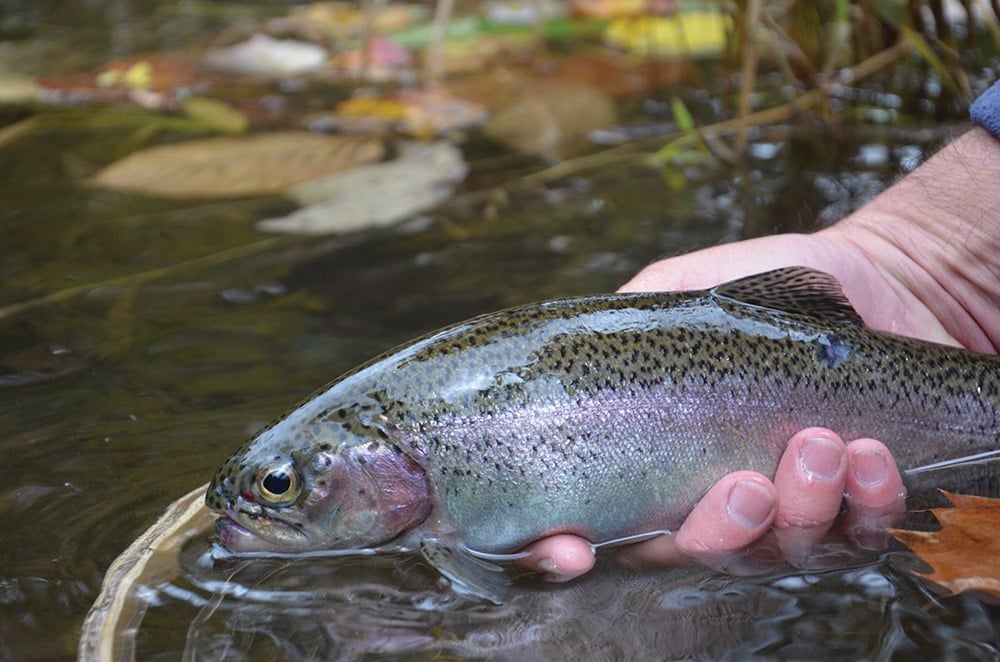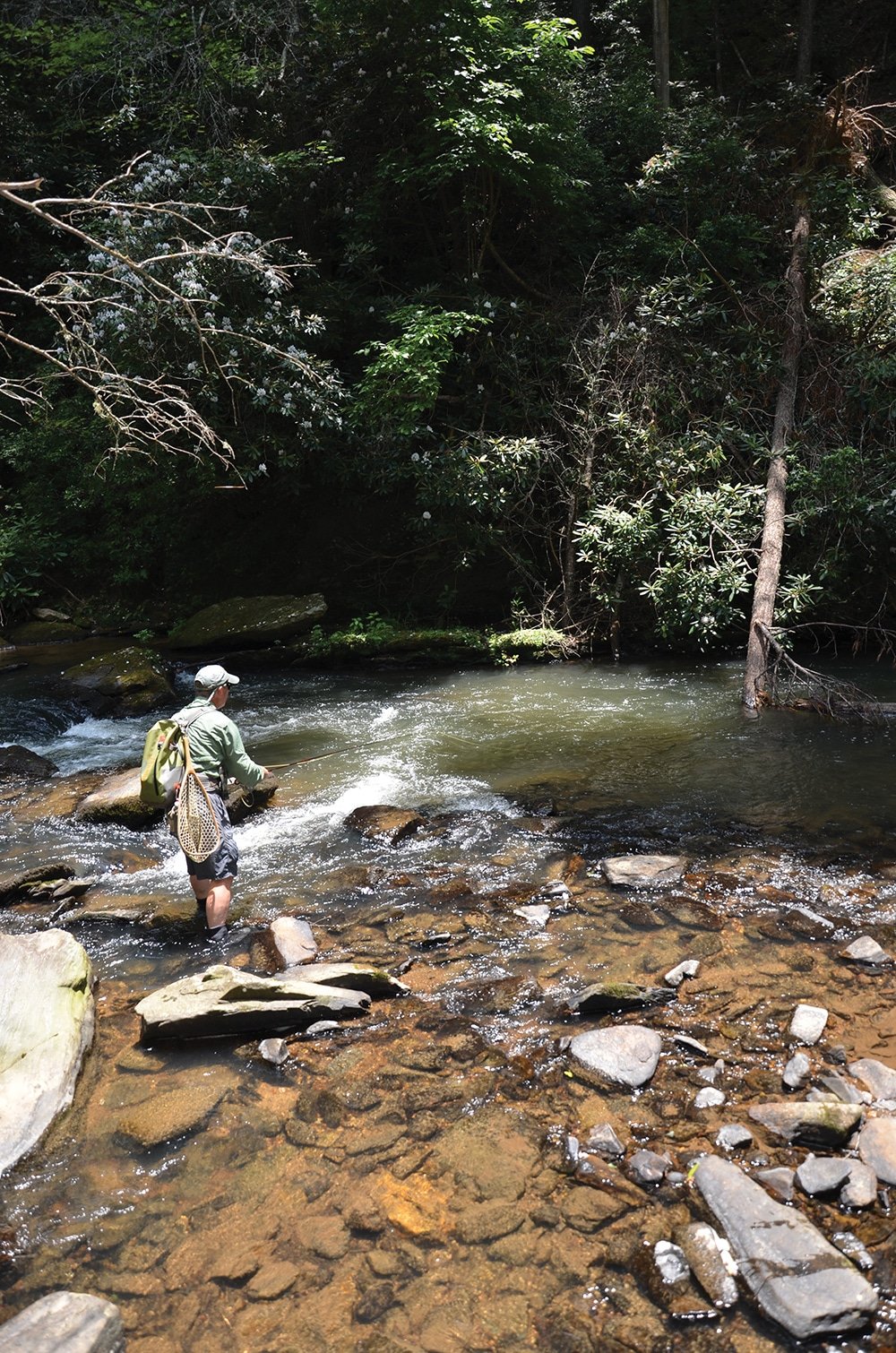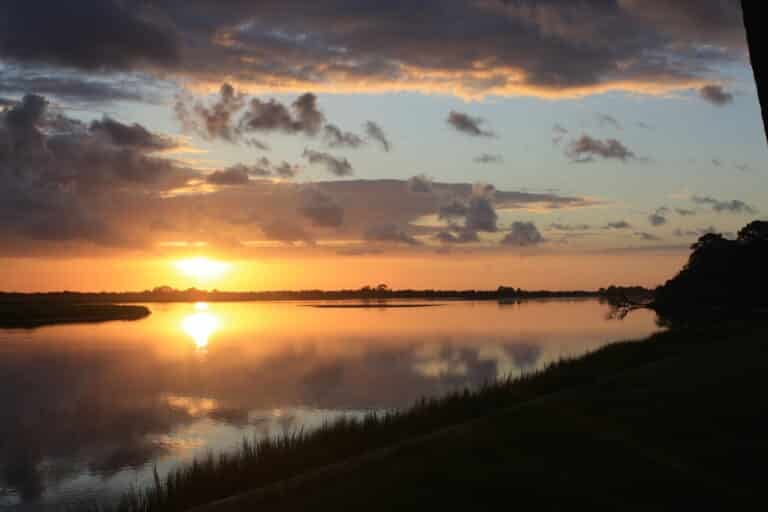Blue Ridge Streams for Winter Trout
It may feel a little too cold to cast a line, but the chilly months at the end of the year offer new opportunities for fly fishing. The warm, low-water conditions of the early fall are over. Trout are rejuvenated by increased flows and cold nights. They are feeding up before hard winter, which makes now a great time to be on the water.
It’s primetime on specially regulated trout waters of the Blue Ridge. These fisheries are intentionally tailored to fly fishing and give anglers a very good reason to brave the cold weather. Delayed harvest (DH) waters around the East carry us through to spring with heavy stockings and catch-and-release, artificial-only regulations. Also, streams with year-round special regulations fish very well when insect abundance wanes and trout are forced to feed opportunistically.
Here’s a look at some of the best special-regulations waters around the region:
Chauga River, South Carolina
There are a handful of really good backcountry trout streams in Upstate South Carolina. Among them is the Chauga River, which features some 20 miles of remote, lightly pressured water known for brown trout.
About an hour and a half west of Greenville, the Chauga flows a ridge east of the well-known Chattooga River. That’s part of what makes the Chauga such a great option during South Carolina’s Nov. 1-May 14 DH season. The Chattooga draws most of the fishing pressure, allowing the Chauga to fly under the radar.
The Chauga fishes just like the Chattooga, only a little smaller, explains Karl Eckberg of Chattooga River Fly Shop. The river’s ledges, drop-offs, deep river-bend holes, and an abundance of riffle water hold rainbows, browns, and brookies. There are only two access points to the 3-mile DH stretch. And despite a good trail, Ekberg says the middle portion of the specially regulated water hardly gets touched.
Early in the season, freshly stocked trout are suckers for the “big flashy and rubbery stuff,” adds Ekberg. Load your box with Mop Flies, Y2Ks, Squirmy Worms, and Gummy Worms. Micro streamers become more important as the season progresses, but fall and winter also offer hatches of midges, blue-winged olives, and little black stoneflies.
Of course, cool weather is always a great time to hunt for big cagey browns in the South. If you wander out of the DH section, try dredging deep holes with big, heavy streamers and stonefly nymphs.
Go Guided: Karl Ekberg, Chattooga River Fly Shop, Mountain Rest, S.C., (864) 638-2806, chattoogariverflyshop.com.
Nantahala River, North Carolina
There aren’t many places where a gorgeous trout stream exists just a few steps from the road. That’s what you’ll find on the 4-mile DH section of the Nantahala River.
About 20 minutes southeast of Bryson City, Wayah Road hugs the banks of the upper Nantahala, giving no-hassle access to miles of riffles and pocket water, big bridge holes, gorges, and deep plunge pools. It’s a place where anglers can experience the look and feel of a brawling mountain stream without the hike.
There’s one drawback to this situation. Easy access to good fishing attracts a lot of anglers. On pretty weekends during the October into June DH season, the riverside pullouts fill up with vehicles sporting rod racks and license plates from all over the country. Stocked trout grow wise quickly under all that pressure, which is a challenge some anglers relish.
There are good numbers of standard hatchery-sized rainbows, browns, and brook trout. And big fish are known to stake claim to the best holding water. If spotting and sneaking up on a 20-inch behemoth in shallow water sounds fun, the upper Nantahala is a good place to do it.
For a few days after a stocking, the usual flashy “junk food” flies are effective, but Nantahala fish learn quickly to spot a fake. Fall and winter bring out winter stoneflies, blue-winged olives, midges, and maybe even a few small caddis. Spring ushers in a riot of bug life, which makes for excellent dry fly fishing.
Another advantage of the Nantahala DH is it’s within an easy drive of a whole lot of other good trout water.
Go Guided: Ken Kastorff, Endless River Adventures, Bryson City, N.C., (828) 488-6199, www.endlessriveradventures.com.

Hatchery Creek, Kentucky
Hatchery Creek warrants inclusion in this list because… well… mainly because it’s really cool.
You wouldn’t know by looking, but this stream south of Jamestown is man-made. Completed in 2016, it’s a mini-tailrace, fed by cold water from Cumberland Lake through the bottom of Wolf Creek Dam. The 1-mile stretch of catch-and-release, artificial-only trout stream is an innovative approach to handling water flushed from Wolf Creek Fish Hatchery. Instead of piping the nutrient-rich water to the nearby Cumberland River or running it through a silty ditch, Kentucky built a trout stream.
And while heavy machinery constructed the streambed, the fish are more organic. Hatchery Creek takes advantage of the much larger Cumberland, which is a world-class tailwater trout fishery.
By design, browns and rainbows from the big river run up Hatchery Creek. The result is a fishery where anglers frequently encounter large river-run fish. It fishes very well during the cool months from October through March.
“The average fish is probably 10 to 16 inches,” said Reidar Crosswell, fishing manager of the Louisville Orvis. “But people catch big fish there all the time. Last time I fished it, I caught several longer than 18 inches.”
Because it was designed, Hatchery Creek has all sorts of trouty habitat, from riffles and runs tailing into slow woody pools to steep descents through series of plunge pools. All of it is wadeable, most of it is fishable from manicured banks, and Crosswell said Euro nymphing with long, lightweight rods is particularly deadly.
He suggests tight-lining multiple nymphs anchored by a big, heavy Pat’s Rubber Legs. Like many streams influenced by hatchery outflow, tiny midges, sow bugs, and scuds thrive in Hatchery Creek. Nymphs from size 16 down to tiny size 22 midge larvae are the ticket. Weight is important to stay in contact with a Euro-nymph rig, so fast-sinking flies like Copper Johns and jig-head patterns like a Pheasant Tail or Duracell work well.
Go Guided: Reidar Crosswell, Louisville Orvis, (502) 425-0198, www.stores.orvis.com/us/kentucky/louisville.
North River, Virginia
In the mountains west of Staunton, Virginia, the North River is a stream that changes personality several times. In its headwaters upstream of Elkhorn Lake, the North River is a remote native brook trout stream. Downstream of Staunton Reservoir, it is a put-and-take stocked trout fishery. Between the two small reservoirs, there is about a mile and a half of DH water that is accessible only by the trail from parking area at the base of Elkhorn Dam.
“It’s beautiful water. In my opinion, it’s some of the prettiest delayed-harvest water in the state,” said Andy Slawson, with Mossy Creek Fly Fishing. “There’s plenty of water to move around and find fish in.”
During the DH season from October 1 – June 15, the state stocks good numbers of 10- to 16-inch rainbows that are suckers for streamers and attractor nymphs through the winter months.
Slawson said this stretch of water really shines in spring, when the mayflies show up and bring excellent dry fly fishing. Starting in about April, fish look to the surface for good hatches of blue-winged olives, sulphurs, and Quill Gordons.
Because it’s a good fishery, the North River sees some fishing pressure during the DH season, but its remote location ensures anglers will be able to find some open water. Slawson said the river is a mountain stream with lots of riffle water leading into deeper pools with woody debris. Large boulders and rock ledges provide interesting runs and pockets. And it’s all relatively shallow, so wading is easy.
Go Guided: Mossy Creek Fly Fishing, mossycreekflyfishing.com, (540) 434-2444, [email protected].
Savage River, Maryland
Up in the northwest corner of Maryland, the Savage River tailrace is a wild trout stream that’s pretty much catch-and-release only, thanks to special regulations. It hasn’t been stocked since the 1990s, and populations of native brookies and reproducing brown trout are booming.
This piece of water downstream of Savage River Reservoir is open year-round and features about a mile of river restricted to fly fishing only and another 3 miles regulated as a Trophy Trout Management Area. The entire stretch is artificial only, and there is a two fish limit on brook trout longer than 12 inches or brown trout longer than 18 inches.
“It’s pretty much catch-and-release, artificial-only,” said James Harris, owner of Beaver Creek Fly Shop. “There are some big ones in there, but I don’t ever see people keeping them.”
The Savage tailwater runs parallel to Savage River Road, and there are a couple small tracts of private land anglers need to steer clear of. The pull-outs and parking areas make it obvious where you’re allowed to fish.
The river flows between forested hillsides. Bring your wading stick because the streambed is mostly cobblestone and boulders that can be very slippery.
“It’s a picturesque Appalachian mountain stream,” said Harris. “It’s all pocket water and big long flats with big boulders.”
Harris said 18- to 20-inch brown trout are a definite possibility on those cold sunny days that call for anglers to fish big sculpin or minnow patterns on sinking line. Good numbers of 12- to 16-inch browns and 6- to 10-inch brookies are susceptible to tight-line nymphing with big stoneflies and midge larvae.
Go Guided: Beaver Creek Fly Shop, beavercreekflyshop.com, (301) 393-9090.
Cover Photo: Karl Eckberg, of the Chattooga River Fly Shop in upstate South Carolina, tight-lines a run in the delayed harvest section of Chauga River. Photo by Nick Carter








